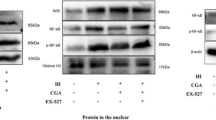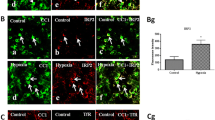Abstract
Hypoxic-ischemic brain damage (HIBD) poses a significant risk of neurological damage in newborns. This study investigates the impact of endoplasmic reticulum stress (ERS) on neuronal damage in neonatal HIBD and its underlying mechanisms. HIBD neonatal rat model was constructed and pre-treated with 4-phenylbutiric acid (4-PBA). Nissl and TUNEL staining were utilised to assess neuronal damage and apoptosis in rat brains. HIBD cell model was established by inducing oxygen-glucose deprivation (OGD) in rat H19-7 neurons, which were then pre-treated with Thapsigargin (TG), Ferrostatin-1 (Fer-1), or both. Cell viability and apoptosis of H19-7 neurons were analysed using cell counting kit-8 assay and TUNEL staining. GRP78-PERK-CHOP pathway activity and glutathione peroxidase-4 (GPX4) expression in rat brains and H19-7 neurons were assessed using Western blot. Ferroptosis-related indicators, including glutathione (GSH), superoxide dismutase (SOD), malondialdehyde (MDA) and iron content, were measured using commercial kits in both rat brains and H19-7 neurons. GRP78-PERK-CHOP pathway was overactivated in HIBD neonatal rats’ brains, which was mitigated by 4-PBA treatment. 4-PBA treatment demonstrated a reduction in neuronal damage and apoptosis in HIBD-affected neonatal rat brains. Furthermore, it attenuated ferroptosis in rats by increasing GPX4, GSH and SOD while decreasing MDA and iron content. In the OGD-induced H19-7 neurons, Fer-1 treatment counteracted the suppressive effects of TG on viability, the exacerbation of apoptosis, the promotion of ferroptosis and the activation of the GRP78-PERK-CHOP pathway. Overall, ERS facilitates neuronal damage in neonatal HIBD by inducing ferroptosis. Consequently, the suppression of ERS may represent a promising therapeutic strategy for treating neonatal HIBD.






Similar content being viewed by others
Data Availability
The datasets used or analyzed during the current study are available from the corresponding author on reasonable request.
References
Zhu, K., Zhu, X., Liu, S., Yu, J., Wu, S., & Hei, M. (2022). Glycyrrhizin attenuates hypoxic-ischemic brain damage by inhibiting ferroptosis and Neuroinflammation in neonatal rats via the HMGB1/GPX4 pathway. Oxidative Medicine and Cellular Longevity, 2022, 8438528.
Min, Y. J., Ling, E. A., & Li, F. (2020). Immunomodulatory mechanism and potential therapies for Perinatal hypoxic-ischemic brain damage. Frontiers in Pharmacology, 11, 580428.
Niu, X., Jiao, Z., Wang, Z., Jiang, A., Zhang, X., Zhang, H., et al. (2022). MiR-17-5p protects neonatal mice from hypoxic-ischemic brain damage by targeting Casp2. Neuroscience Letters, 772, 136475.
Yu, L., Liu, S., Zhou, R., Sun, H., Su, X., Liu, Q., et al. (2022). Atorvastatin inhibits neuronal apoptosis via activating cAMP/PKA/p-CREB/BDNF pathway in hypoxic-ischemic neonatal rats. FASEB Journal: Official Publication of the Federation of American Societies for Experimental Biology, 36(4), e22263.
Huang, G., Zang, J., He, L., Zhu, H., Huang, J., Yuan, Z., et al. (2022). Bioactive nanoenzyme reverses oxidative damage and endoplasmic reticulum stress in neurons under ischemic stroke. ACS nano, 16(1), 431–452.
Chen, X., Mi, L., Gu, G., Gao, X., Gao, X., Shi, M., et al. (2022). Dysfunctional endoplasmic reticulum-mitochondrion coupling is Associated with endoplasmic reticulum stress-Induced apoptosis and neurological deficits in a rodent model of severe Head Injury. Journal of Neurotrauma, 39(7–8), 560–576.
Niu, J., Wu, Z., Xue, H., Zhang, Y., Gao, Q., Li, C., et al. (2021). Sevoflurane post-conditioning alleviated hypoxic-ischemic brain injury in neonatal rats by inhibiting endoplasmic reticulum stress-mediated autophagy via IRE1 signalings. Neurochemistry International, 150, 105198.
Hu, Y., Wang, Z., Pan, S., Fang, M., Jiang, H., Mao, Y., et al. (2017). Inhibition of endoplasmic reticulum stress is involved in the neuroprotective effect of aFGF in neonatal hypoxic-ischaemic brain injury. Oncotarget, 8(37), 60941–60953.
Bai, X., Liu, S., Yuan, L., Xie, Y., Li, T., Wang, L., et al. (2016). Hydrogen-rich saline mediates neuroprotection through the regulation of endoplasmic reticulum stress and autophagy under hypoxia-ischemia neonatal brain injury in mice. Brain Research, 1646, 410–417.
Wang, Y., Tu, L., Li, Y., Chen, D., & Wang, S. (2016). Notoginsenoside R1 protects against neonatal cerebral hypoxic-ischemic Injury through Estrogen receptor-dependent activation of endoplasmic reticulum stress pathways. The Journal of Pharmacology and Experimental Therapeutics, 357(3), 591–605.
Fang, M., Yuan, J., Jiang, S., Hu, Y., Pan, S., Zhu, J., et al. (2020). Dl-3-n-butylphthalide attenuates hypoxic-ischemic brain injury through inhibiting endoplasmic reticulum stress-induced cell apoptosis and alleviating blood-brain barrier disruption in newborn rats. Brain Research, 1747, 147046.
Xue, Q., Yan, D., Chen, X., Li, X., Kang, R., Klionsky, D. J., et al. (2023). Copper-dependent autophagic degradation of GPX4 drives ferroptosis. Autophagy, 19(7), 1982–1996.
Lin, W., Zhang, T., Zheng, J., Zhou, Y., Lin, Z., & Fu, X. (2022). Ferroptosis is involved in hypoxic-ischemic brain damage in neonatal rats. Neuroscience, 487, 131–142.
Zeng, T., Zhou, Y., Yu, Y., Wang, J. W., Wu, Y., Wang, X., et al. (2023). rmMANF prevents sepsis-associated lung injury via inhibiting endoplasmic reticulum stress-induced ferroptosis in mice. International Immunopharmacology, 114, 109608.
He, Z., Shen, P., Feng, L., Hao, H., He, Y., Fan, G., et al. (2022). Cadmium induces liver dysfunction and ferroptosis through the endoplasmic stress-ferritinophagy axis. Ecotoxicology and Environmental Safety, 245, 114123.
Hui, Z., Wang, S., Li, J., Wang, J., & Zhang, Z. (2022). Compound Tongluo Decoction inhibits endoplasmic reticulum stress-induced ferroptosis and promoted angiogenesis by activating the Sonic hedgehog pathway in cerebral infarction. Journal of Ethnopharmacology, 283, 114634.
Zheng, J., Fang, Y., Zhang, M., Gao, Q., Li, J., Yuan, H., et al. (2024). Mechanisms of ferroptosis in hypoxic-ischemic brain damage in neonatal rats. Experimental Neurology, 372, 114641.
You, Q., Lan, X. B., Liu, N., Du, J., Ma, L., Yang, J. M., et al. (2023). Neuroprotective strategies for neonatal hypoxic-ischemic brain damage: Current status and challenges. European Journal of Pharmacology, 957, 176003.
Zuo, M. Y., Tang, T. J., Wang, X., Gu, J. F., Wang, L., Chen, J. (2022). Atractylenolide III Attenuates Apoptosis in H9c2 Cells by Inhibiting Endoplasmic Reticulum Stress through the GRP78/PERK/CHOP Signaling Pathway. Evidence-based complementary and alternative medicine: eCAM. ;2022:1149231.
Thornton, C., Baburamani, A. A., Kichev, A., & Hagberg, H. (2017). Oxidative stress and endoplasmic reticulum (ER) stress in the development of neonatal hypoxic-ischaemic brain injury. Biochemical Society Transactions, 45(5), 1067–1076.
Doğanyiğit, Z., Okan, A., Akyüz, E., Yılmaz, S., Ateş, Ş., Taheri, S., et al. (2023). Can endoplasmic reticulum stress observed in the PTZ-kindling model seizures be prevented with TUDCA and 4-PBA? European Journal of Pharmacology, 960, 176072.
Wu, Z., Niu, J., Xue, H., Wang, S., & Zhao, P. (2021). Sodium 4-Phenylbutyrate protects hypoxic-ischemic brain Injury via attenuating endoplasmic reticulum stress in neonatal rats. Frontiers in Behavioral Neuroscience, 15, 632143.
Zhang, M., Liu, Z., Zhou, W., Shen, M., Mao, N., Xu, H., et al. (2023). Ferrostatin-1 attenuates hypoxic-ischemic brain damage in neonatal rats by inhibiting ferroptosis. Translational Pediatrics, 12(11), 1944–1970.
Zhang, M., Lin, W., Tao, X., Zhou, W., Liu, Z., Zhang, Z., et al. (2023). Ginsenoside Rb1 inhibits ferroptosis to ameliorate hypoxic-ischemic brain damage in neonatal rats. International Immunopharmacology, 121, 110503.
Chen, Y., Li, X., Wang, S., Miao, R., & Zhong, J. (2023). Targeting Iron Metabolism and Ferroptosis as Novel Therapeutic approaches in Cardiovascular diseases. Nutrients. ;15(3).
Hirata, Y., Cai, R., Volchuk, A., Steinberg, B. E., Saito, Y., Matsuzawa, A., et al. (2023). Lipid peroxidation increases membrane tension, Piezo1 gating, and cation permeability to execute ferroptosis. Current Biology: CB, 33(7), 1282–94e5.
Xing, G., Meng, L., Cao, S., Liu, S., Wu, J., Li, Q., et al. (2022). PPARα alleviates iron overload-induced ferroptosis in mouse liver. EMBO Reports, 23(8), e52280.
Du, S., Shi, H., Xiong, L., Wang, P., & Shi, Y. (2022). Canagliflozin mitigates ferroptosis and improves myocardial oxidative stress in mice with diabetic cardiomyopathy. Frontiers in Endocrinology, 13, 1011669.
Jiang, Y., Cui, J., Cui, M., & Jing, R. (2023). SLC7A11 promotes the progression of gastric cancer and regulates ferroptosis through PI3K/AKT pathway. Pathology Research and Practice, 248, 154646.
Yang, Y., Wu, Q., Shan, X., Zhou, H., Wang, J., Hu, Y., et al. (2024). Ginkgolide B attenuates cerebral ischemia-reperfusion injury via inhibition of ferroptosis through disrupting NCOA4-FTH1 interaction. Journal of Ethnopharmacology, 318(Pt B), 116982.
Wang, D., Zu, Y., Sun, W., & Fan, X. (2023). Setd1A-mediated methylation of h3k4me3 inhibits ferroptosis in non-small cell lung cancer by regulating the WTAPP1/WTAP axis. Current medicinal chemistry.
Lv, Y., Wu, M., Wang, Z., Wang, J., & Ferroptosis (2023). From regulation of lipid peroxidation to the treatment of diseases. Cell Biology and Toxicology, 39(3), 827–851.
Endale, H. T., Tesfaye, W., & Mengstie, T. A. (2023). ROS induced lipid peroxidation and their role in ferroptosis. Frontiers in cell and Developmental Biology, 11, 1226044.
Xu, J., Zhao, L., Zhang, X., Ying, K., Zhou, R., Cai, W., et al. (2023). Salidroside ameliorates acetaminophen-induced acute liver injury through the inhibition of endoplasmic reticulum stress-mediated ferroptosis by activating the AMPK/SIRT1 pathway. Ecotoxicology and Environmental Safety, 262, 115331.
Liu, Z., Nan, P., Gong, Y., Tian, L., Zheng, Y., & Wu, Z. (2023). Endoplasmic reticulum stress-triggered ferroptosis via the XBP1-Hrd1-Nrf2 pathway induces EMT progression in diabetic nephropathy (Vol. 164, p. 114897). Biomedicine & pharmacotherapy = Biomedecine & pharmacotherapie.
Funding
Ningxia Natural Science Foundation, the role of endoplasmic reticulum stress in the regulation of brain injury in hypoxic-ischemic rats (2022AAC03705).
Author information
Authors and Affiliations
Corresponding author
Ethics declarations
Consent for Publication
The authors consent for publication in the Journal.
Competing Interests
The authors declare no competing interests.
Additional information
Publisher’s Note
Springer Nature remains neutral with regard to jurisdictional claims in published maps and institutional affiliations.
Electronic Supplementary Material
Below is the link to the electronic supplementary material.
Rights and permissions
Springer Nature or its licensor (e.g. a society or other partner) holds exclusive rights to this article under a publishing agreement with the author(s) or other rightsholder(s); author self-archiving of the accepted manuscript version of this article is solely governed by the terms of such publishing agreement and applicable law.
About this article
Cite this article
Ji, Y., Liu, H., Niu, F. et al. Endoplasmic Reticulum Stress Promotes Neuronal Damage in Neonatal Hypoxic-Ischemic Brain Damage by Inducing Ferroptosis. Mol Biotechnol (2024). https://doi.org/10.1007/s12033-024-01095-9
Received:
Accepted:
Published:
DOI: https://doi.org/10.1007/s12033-024-01095-9




